VARANASI, INDIA - As Arvind, our scholarly guide, leads us to the Dashashwamedh Ghat (the main steps that take us to the Ganges River here in Hinduism’s holiest city) a priest grabs my wrist and turns me towards him.
He ceremoniously places a tika (red dot) between my eyebrows and ties a red woven bracelet with beads on my wrist. He then puts his hand on my head and gives me a blessing.
My knees weaken and I can feel his energy entering my body as he continues to chant.
Suddenly, tears well up in my eyes and I’m overcome with emotion. I feel like this holy man has brought me closer to the divine. I’ll never forget this moment.
Opening up to new experiences, as I’ve learned from travelling to places of wonder like India and Israel, is sometimes difficult for Western travellers with our “logical” minds. But in this holy city on the banks of Mother Ganges in Uttar Pradesh province, I learned to think more “vertically” than “horizontally.”
“Look up,” Arvind tells us. “Let the divine in you lead you to new truths and new ways of thinking.”
Arvind, a teacher of Hindu philosophy at Banaras Hindu University, as well as several schools in the United States, spends two days with me and my three travelling companions, showing us the sights and eagerly answering our questions. He helps us understand a small portion of the intricacies of Hindu beliefs and culture.
“How many Hindu gods are there?” wonders Judi, as we float on the Ganges toward the Manikarnika Ghat.
“One,” Arvind replies without hesitation, explaining that God is without form and without gender.
“But in order for God to talk to humankind, He needed to take on a corporeal form, which is why Hinduism has so many gods and goddesses.”
The Manikarnika Ghat is the main cremation site in Varanasi and Hindus from all over India — and the world, for that matter — bring their dead here. Hindus believe that if a person is cremated here, that person gets liberation (moksha), and will no longer have to go through the pain of death and rebirth that is one of the foundational believes of Hinduism, Arvind tells us.
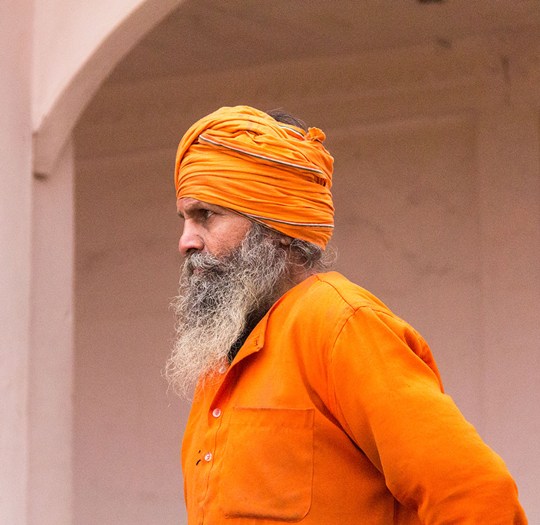
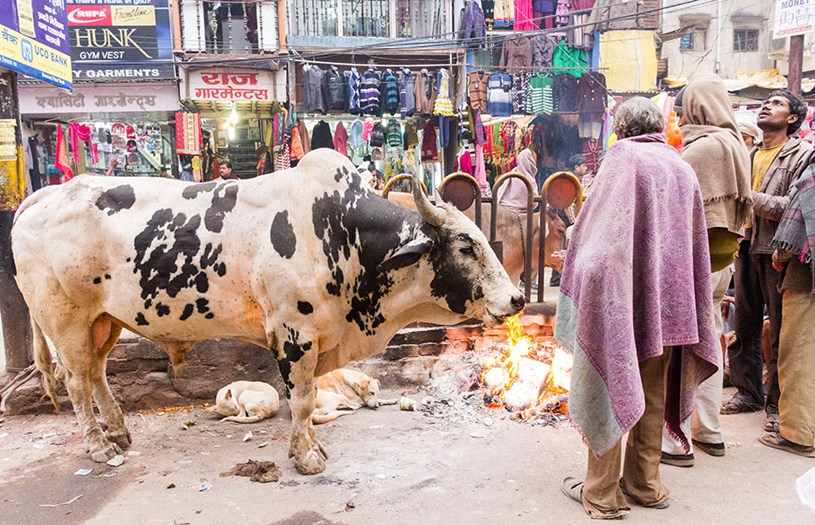
Left: Every Indian dreams of making a pilgrimage to Varanasi. Right: The sacred cow wanders the streets of the holy city.
As we watch the men (only male relatives perform the funeral rituals) prepare their dead by immersing the bodies in the river and then setting up the funeral pyres, I find myself deeply moved by the care that is bestowed upon the dead in this ancient place, one of the oldest continuously inhabited cities in the world.
Mark Twain once wrote of Varanasi that it is “older than history, older than tradition, older even than legend and looks twice as old as all of them put together.”
But the highlight of any visit here is the evening Aarti Ceremony at the Dashashwamedh Ghat, when seven priests on seven wooden platforms perform the “Agni Pooja” (worship to fire), a dedication to Lord Shiva, the River Ganga, Surya (sun), Agni (fire) and the entire universe.
“We put Mother Ganges to bed every night,” says Arvind, “with one of the most beautiful rituals in Hinduism.”

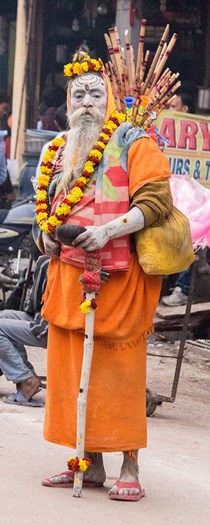
Left: The night ceremony where they put Mother Ganges to bed is a fiery spectacle. Right: Priests in colourful outfits walk the streets of Varanasi daily.
And beautiful it is. The seven priests perform the well-choreographed rites, singing and chanting, blowing conch shells and burning incense, lighting huge candelabras, throwing saffron-coloured flower petals (marigolds), and shaking yak-tail fans and peacock feathers.
There are many places to view the Aarti Ceremony, including from a boat on the river and from rooftops — for a small price (about $2). Arvind arranges for us to sit at one end of the platforms next to the river in full view of the saffron-robed priests.
During the 45-minute ceremony, I again feel the energy and spiritual lift I experienced earlier in the day.
It’s during the day that the nearly 100 ghats in Varansi come alive with devotees who make their pilgrimage to the Ganges for a spiritual bath. Dashashwamedh Ghat is the most popular and accessible bathing spot, with rows of priests setting up on wooden platforms under bamboo umbrellas, where boatmen jostle for customers, vendors sell small candles set in marigold petals that are then lit and floated in the river, and Hindu ascetics (renouncers) beg for alms before making their way to the Kashi Vishwanath Temple, or Golden Temple, for prayers.
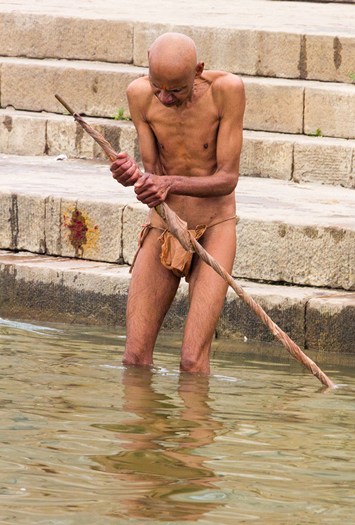
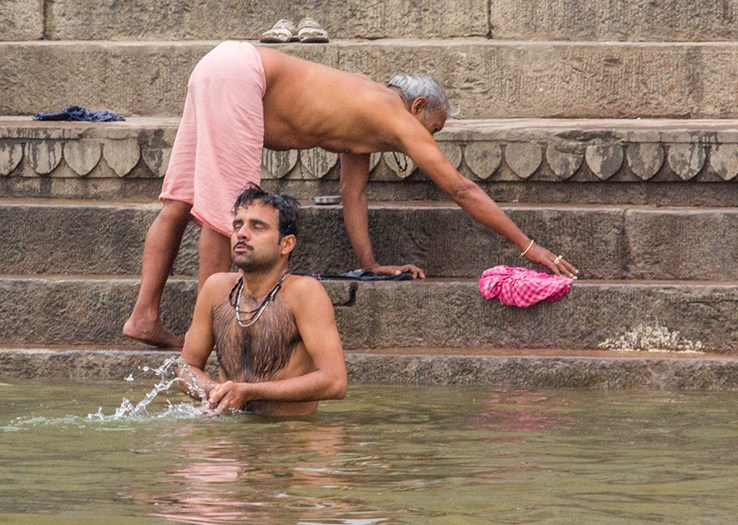
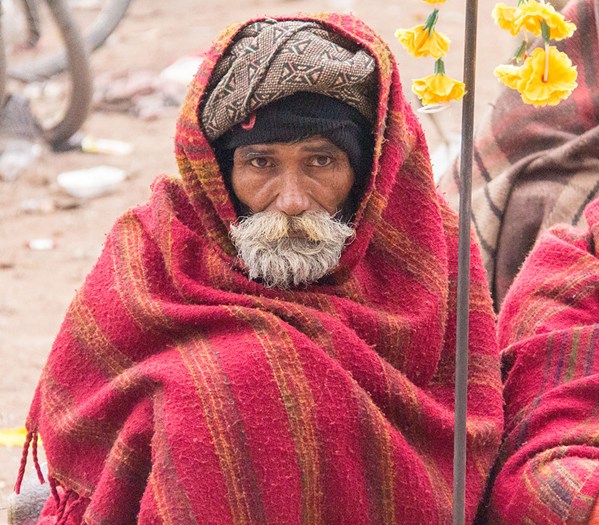
Left: The old, sick, poor and rich come to Varanasi to soak in the holy water of the Ganges River. Middle: They soak in the holy water of the Ganges and feel cleansed of body, mind and soul. Right: Beggers bundle up from the cool morning air waiting their turn in the holy water.
The temple, dedicated to Lord Shiva, is one of the most important places of worship in the Hindu religion, Arvind tells us, and a visit there, along with a bath in the Ganges, is one of the methods that is believed to take adherents on the path to moksha.
Back home, I meditate a great deal on my experiences in Varanasi, and I feel liberated.
Information
Tour East Holidays offers many affordably-priced tours to India. Go to www.toureast.com / Air France, Air Canada, Air India and Jet Airways all offer flights to India from Toronto, Calgary, Montreal and Vancouver.
About the Author
A former award-winning editor at the Toronto Star, Gale has travelled extensively throughout Europe, Asia and North America and will share her unique style of writing and photography with TraveLife readers. Gale’s favourite places I the world include India, China, Thailand, Paris, Scotland and London.